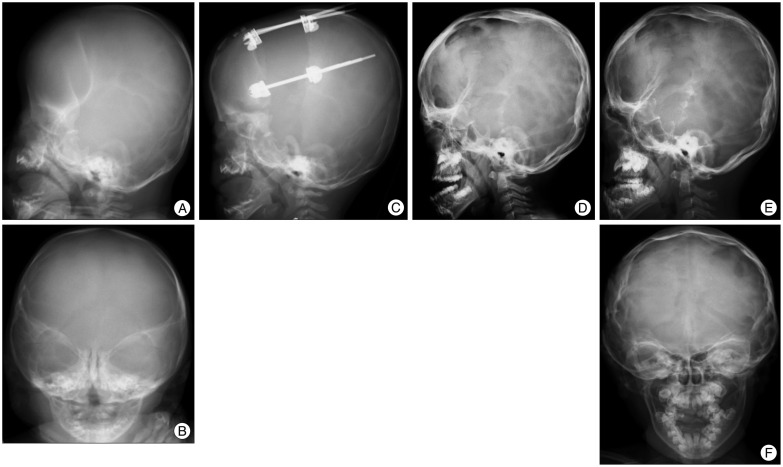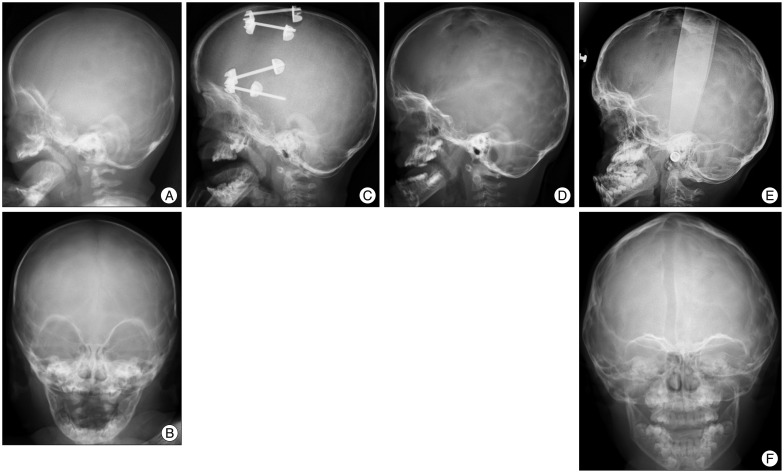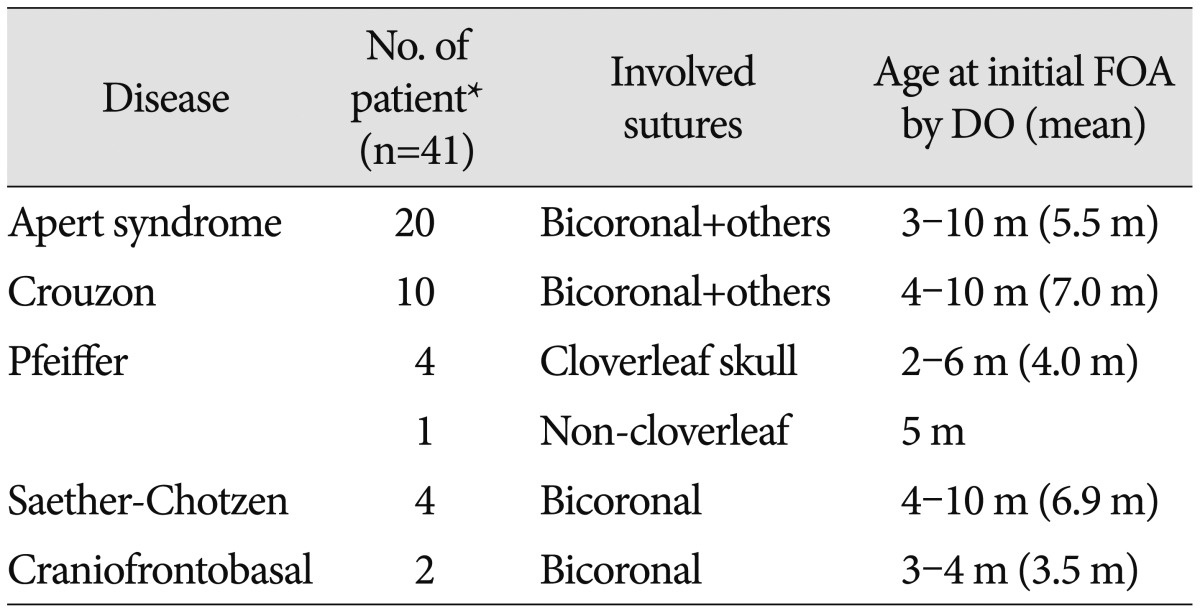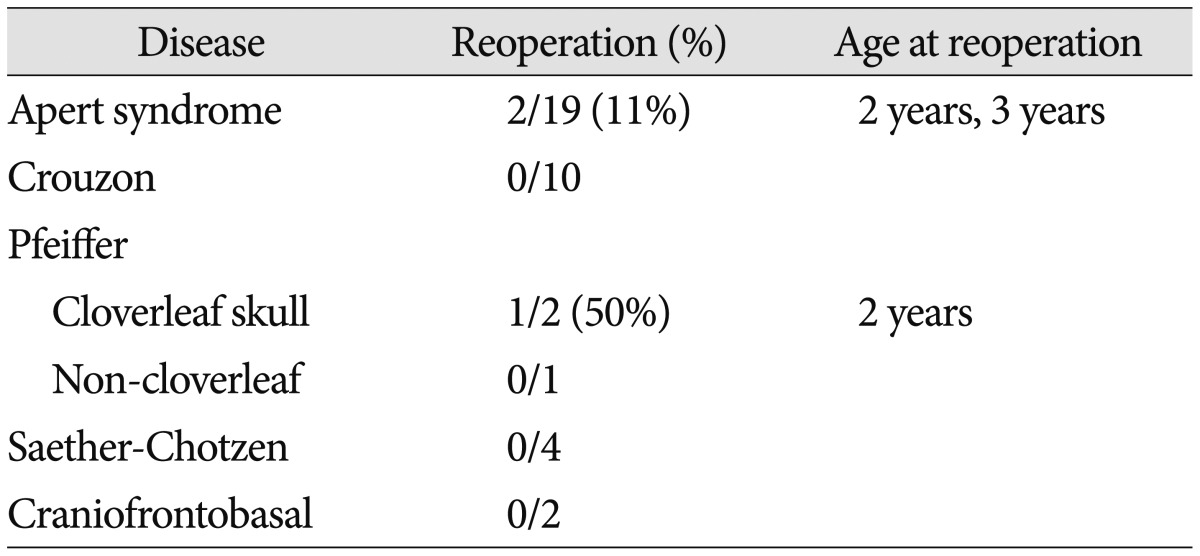1. Addo NK, Javadpour S, Kandasamy J, Sillifant P, May P, Sinha A. Central sleep apnea and associated Chiari malformation in children with syndromic craniosynostosis : treatment and outcome data from a supraregional national craniofacial center. J Neurosurg Pediatr. 2013; 11:296–301. PMID:
23240845.

2. Akai T, Shiraga S, Sasagawa Y, Iizuka H, Yamashita M, Kawakami S. Troubleshooting distraction osteogenesis for craniosynostosis. Pediatr Neurosurg. 2013; 49:380–383. PMID:
25500456.

3. Arnaud E, Marchac D, Renier D. Reduction of morbidity of the fronto-facial monobloc advancement in children by the use of internal distraction. Plast Reconstr Surg. 2007; 120:1009–1026. PMID:
17805131.

4. Bannink N, Mathijssen IM, Joosten KF. Can parents predict obstructive sleep apnea in children with syndromic or complex craniosynostosis? Int J Oral Maxillofac Surg. 2010; 39:421–423. PMID:
20206474.

5. Cho BC, Hwang SK, Uhm KI. Distraction osteogenesis of the cranial vault for the treatment of craniofacial synostosis. J Craniofac Surg. 2004; 15:135–144. PMID:
14704580.

6. Choi M, Flores RL, Havlik RJ. Volumetric analysis of anterior versus posterior cranial vault expansion in patients with syndromic craniosynostosis. J Craniofac Surg. 2012; 23:455–458. PMID:
22421838.

7. Cinalli G, Renier D, Sebag G, Sainte-Rose C, Arnaud E, Pierre-Kahn A. Chronic tonsillar herniation in Crouzon's and Apert's syndromes : the role of premature synostosis of the lambdoid suture. J Neurosurg. 1995; 83:575–582. PMID:
7674004.

8. Cinalli G, Sainte-Rose C, Kollar EM, Zerah M, Brunelle F, Chumas P, et al. Hydrocephalus and craniosynostosis. J Neurosurg. 1998; 88:209–214. PMID:
9452225.

9. Cinalli G, Spennato P, Sainte-Rose C, Arnaud E, Aliberti F, Brunelle F, et al. Chiari malformation in craniosynostosis. Childs Nerv Syst. 2005; 21:889–901. PMID:
15875201.

10. Cohen MM Jr. Pfeiffer syndrome. In : Cohen MM, editor. Craniosynostosis, diagnosis, evaluation, and management. ed 2. New York: Oxford University Press;2000. p. 354–360.
11. Collmann H, Sörensen N, Krauss J. Hydrocephalus in craniosynostosis : a review. Childs Nerv Syst. 2005; 21:902–912. PMID:
15864600.
12. de Jong T, Bannink N, Bredero-Boelhouwer HH, van Veelen ML, Bartels MC, Hoeve LJ, et al. Long-term functional outcome in 167 patients with syndromic craniosynostosis; defining a syndrome-specific risk profile. J Plast Reconstr Aesthet Surg. 2010; 63:1635–1641. PMID:
19913472.

13. de Jong T, Maliepaard M, Bannink N, Raat H, Mathijssen IM. Health-related problems and quality of life in patients with syndromic and complex craniosynostosis. Childs Nerv Syst. 2012; 28:879–882. PMID:
22234545.

14. de Jong T, Rijken BF, Lequin MH, van Veelen ML, Mathijssen IM. Brain and ventricular volume in patients with syndromic and complex craniosynostosis. Childs Nerv Syst. 2012; 28:137–140. PMID:
22011964.

15. Derderian C, Seaward J. Syndromic craniosynostosis. Semin Plast Surg. 2012; 26:64–75. PMID:
23633933.

16. Derderian CA, Bastidas N, Bartlett SP. Posterior cranial vault expansion using distraction osteogenesis. Childs Nerv Syst. 2012; 28:1551–1556. PMID:
22872272.

17. Di Rocco F, Jucá CE, Arnaud E, Renier D, Sainte-Rose C. The role of endoscopic third ventriculostomy in the treatment of hydrocephalus associated with faciocraniosynostosis. J Neurosurg Pediatr. 2010; 6:17–22. PMID:
20593982.

18. Fearon JA, McLaughlin EB, Kolar JC. Sagittal craniosynostosis : surgical outcomes and long-term growth. Plast Reconstr Surg. 2006; 117:532–541. PMID:
16462336.
19. Fearon JA, Rhodes J. Pfeiffer syndrome : a treatment evaluation. Plast Reconstr Surg. 2009; 123:1560–1569. PMID:
19407629.
20. Flapper WJ, Anderson PJ, Roberts RM, David DJ. Intellectual outcomes following protocol management in Crouzon, Pfeiffer, and Muenke syndromes. J Craniofac Surg. 2009; 20:1252–1255. PMID:
19625842.

21. Fujimoto T, Imai K, Matsumoto H, Sakamoto H, Nakano T. Tracheobronchial anomalies in syndromic craniosynostosis with 3-dimensional CT image and bronchoscopy. J Craniofac Surg. 2011; 22:1579–1583. PMID:
21959391.

22. Goldstein JA, Paliga JT, Wink JD, Low DW, Bartlett SP, Taylor JA. A craniometric analysis of posterior cranial vault distraction osteogenesis. Plast Reconstr Surg. 2013; 131:1367–1375. PMID:
23714797.

23. Goodrich JT, Tepper O, Staffenberg DA. Craniosynostosis : posterior two-third cranial vault reconstruction using bioresorbable plates and a PDS suture lattice in sagittal and lambdoid synostosis. Childs Nerv Syst. 2012; 28:1399–1406. PMID:
22872255.

24. Hirabayashi S, Sugawara Y, Sakurai A, Harii K, Park S. Frontoorbital advancement by gradual distraction. Technical note. J Neurosurg. 1998; 89:1058–1061. PMID:
9833840.
25. Imai K, Komune H, Toda C, Nomachi T, Enoki E, Sakamoto H, et al. Cranial remodeling to treat craniosynostosis by gradual distraction using a new device. J Neurosurg. 2002; 96:654–659. PMID:
11990803.

26. Johnson D, Horsley SW, Moloney DM, Oldridge M, Twigg SR, Walsh S, et al. A comprehensive screen for TWIST mutations in patients with craniosynostosis identifies a new microdeletion syndrome of chromosome band 7p21.1. Am J Hum Genet. 1998; 63:1282–1293. PMID:
9792856.

27. Kim YO, Choi JW, Kim DS, Lee WJ, Yoo SK, Kim HJ, et al. Cranial growth after distraction osteogenesis of the craniosynostosis. J Craniofac Surg. 2008; 19:45–55. PMID:
18216664.

28. Komuro Y, Shimizu A, Shimoji K, Miyajima M, Arai H. Posterior cranial vault distraction osteogenesis with barrel stave osteotomy in the treatment of craniosynostosis. Neurol Med Chir (Tokyo). 2015; 55:617–623. PMID:
26226978.

29. Kreiborg S, Cohen MM Jr. Ocular manifestations of Apert and Crouzon syndromes : qualitative and quantitative findings. J Craniofac Surg. 2010; 21:1354–1357. PMID:
20856021.
30. Lauritzen CG, Davis C, Ivarsson A, Sanger C, Hewitt TD. The evolving role of springs in craniofacial surgery : the first 100 clinical cases. Plast Reconstr Surg. 2008; 121:545–554. PMID:
18300975.

31. Maliepaard M, Mathijssen IM, Oosterlaan J, Okkerse JM. Intellectual, behavioral, and emotional functioning in children with syndromic craniosynostosis. Pediatrics. 2014; 133:e1608–e1615. PMID:
24864183.

32. Marchac D, Renier D, Broumand S. Timing of treatment for craniosynostosis and facio-craniosynostosis : a 20-year experience. Br J Plast Surg. 1994; 47:211–222. PMID:
8081607.

33. Mathijssen IM. Guideline for care of patients with the diagnoses of craniosynostosis : Working Group on Craniosynostosis. J Craniofac Surg. 2015; 26:1735–1807. PMID:
26355968.
34. McCarthy JG, Glasberg SB, Cutting CB, Epstein FJ, Grayson BH, Ruff G, et al. Twenty-year experience with early surgery for craniosynostosis : II. The craniofacial synostosis syndromes and pansynostosis--results and unsolved problems. Plast Reconstr Surg. 1995; 96:284–295. discussion 296-298. PMID:
7624401.
35. Nonaka Y, Oi S, Miyawaki T, Shinoda A, Kurihara K. Indication for and surgical outcomes of the distraction method in various types of craniosynostosis. Advantages, disadvantages, and current concepts for surgical strategy in the treatment of craniosynostosis. Childs Nerv Syst. 2004; 20:702–709. PMID:
15168051.
36. Nowinski D, Di Rocco F, Renier D, SainteRose C, Leikola J, Arnaud E. Posterior cranial vault expansion in the treatment of craniosynostosis. Comparison of current techniques. Childs Nerv Syst. 2012; 28:1537–1544. PMID:
22872270.

37. Park DH, Yoon SH. Transsutural distraction osteogenesis for 285 children with craniosynostosis : a single-institution experience. J Neurosurg Pediatr. 2015; 18:1–10. PMID:
26382181.
38. Rachmiel A, Leiser Y. The molecular and cellular events that take place during craniofacial distraction osteogenesis. Plast Reconstr Surg Glob Open. 2014; 2:e98. PMID:
25289295.

39. Renier D, Arnaud E, Cinalli G, Sebag G, Zerah M, Marchac D. Prognosis for mental function in Apert's syndrome. J Neurosurg. 1996; 85:66–72. PMID:
8683284.

40. Renier D, Lajeunie E, Arnaud E, Marchac D. Management of craniosynostoses. Childs Nerv Syst. 2000; 16:645–658. PMID:
11151714.

41. Renier D, Sainte-Rose C, Marchac D, Hirsch JF. Intracranial pressure in craniostenosis. J Neurosurg. 1982; 57:370–377. PMID:
7097333.

42. Rhodes JL, Tye GW, Fearon JA. Craniosynostosis of the lambdoid suture. Semin Plast Surg. 2014; 28:138–143. PMID:
25210507.

43. Rijken BF, Lequin MH, Van Veelen ML, de Rooi J, Mathijssen IM. The formation of the foramen magnum and its role in developing ventriculomegaly and Chiari I malformation in children with craniosynostosis syndromes. J Craniomaxillofac Surg. 2015; 43:1042–1048. PMID:
26051848.

44. Sacco D, Scott RM. Reoperation for Chiari malformations. Pediatr Neurosurg. 2003; 39:171–178. PMID:
12944696.

45. Samra F, Swanson JW, Mitchell B, Bauder AR, Wes A, Bartlett SP, et al. An evidence-based algorithm for managing syndromic craniosynostosis in the era of posterior vault distraction osteogenesis. Plast Reconstr Surg. 2015; 136(4 Suppl):6–7. PMID:
26397487.

46. Sandberg DI, Navarro R, Blanch J, Ragheb J. Anomalous venous drainage preventing safe posterior fossa decompression in patients with chiari malformation type I and multisutural craniosynostosis. Report of two cases and review of the literature. J Neurosurg. 2007; 106(6 Suppl):490–494. PMID:
17566408.

47. Scott WW, Fearon JA, Swift DM, Sacco DJ. Suboccipital decompression during posterior cranial vault remodeling for selected cases of Chiari malformations associated with craniosynostosis. J Neurosurg Pediatr. 2013; 12:166–170. PMID:
23705893.

48. Seruya M, Oh AK, Boyajian MJ, Posnick JC, Myseros JS, Yaun AL, et al. Long-term outcomes of primary craniofacial reconstruction for craniosynostosis : a 12-year experience. Plast Reconstr Surg. 2011; 127:2397–2406. PMID:
21311385.

49. Sgouros S. Skull vault growth in craniosynostosis. Childs Nerv Syst. 2005; 21:861–870. PMID:
15791470.

50. Sgouros S, Goldin JH, Hockley AD, Wake MJ. Posterior skull surgery in craniosynostosis. Childs Nerv Syst. 1996; 12:727–733. PMID:
9118138.

51. Sgouros S, Hockley AD, Goldin JH, Wake MJ, Natarajan K. Intracranial volume change in craniosynostosis. J Neurosurg. 1999; 91:617–625. PMID:
10507384.

52. Steinbacher DM, Skirpan J, Puchała J, Bartlett SP. Expansion of the posterior cranial vault using distraction osteogenesis. Plast Reconstr Surg. 2011; 127:792–801. PMID:
21285783.

53. Strahle J, Muraszko KM, Buchman SR, Kapurch J, Garton HJ, Maher CO. Chiari malformation associated with craniosynostosis. Neurosurg Focus. 2011; 31:E2. PMID:
21882907.

54. Tamburrini G, Caldarelli M, Massimi L, Gasparini G, Pelo S, Di Rocco C. Complex craniosynostoses : a review of the prominent clinical features and the related management strategies. Childs Nerv Syst. 2012; 28:1511–1523. PMID:
22872268.

55. Taylor JA, Derderian CA, Bartlett SP, Fiadjoe JE, Sussman EM, Stricker PA. Perioperative morbidity in posterior cranial vault expansion : distraction osteogenesis versus conventional osteotomy. Plast Reconstr Surg. 2012; 129:674e–680e.
56. Taylor WJ, Hayward RD, Lasjaunias P, Britto JA, Thompson DN, Jones BM, et al. Enigma of raised intracranial pressure in patients with complex craniosynostosis : the role of abnormal intracranial venous drainage. J Neurosurg. 2001; 94:377–385. PMID:
11235939.

57. Tessier P. Chapter 19. Craniofacial surgery in syndromic craniosynostosis. In : Cohen MM, Maclean RE, editors. Craniosynsotosis. ed 2. New York: Oxford University Press;2000. p. 228–268.
58. Tovetjärn RC, Maltese G, Wikberg E, Bernhardt P, Kölby L, Tarnow PE. Intracranial volume in 15 children with bilateral coronal craniosynostosis. Plast Reconstr Surg Glob Open. 2014; 2:e243. PMID:
25506526.

59. Twigg SR, Wilkie AO. A genetic-pathophysiological framework for craniosynostosis. Am J Hum Genet. 2015; 97:359–377. PMID:
26340332.

60. Utria AF, Mundinger GS, Bellamy JL, Zhou J, Ghasemzadeh A, Yang R, et al. The importance of timing in optimizing cranial vault remodeling in syndromic craniosynostosis. Plast Reconstr Surg. 2015; 135:1077–1084. PMID:
25502856.

61. Whitaker LA, Bartlett SP, Schut L, Bruce D. Craniosynostosis : an analysis of the timing, treatment, and complications in 164 consecutive patients. Plast Reconstr Surg. 1987; 80:195–212. PMID:
3602170.
62. White N, Evans M, Dover MS, Noons P, Solanki G, Nishikawa H. Posterior calvarial vault expansion using distraction osteogenesis. Childs Nerv Syst. 2009; 25:231–236. PMID:
19057909.

63. Winston KR, Ketch LL, Dowlati D. Cranial vault expansion by distraction osteogenesis. J Neurosurg Pediatr. 2011; 7:351–361. PMID:
21456905.

64. Winston KR, Stence NV, Boylan AJ, Beauchamp KM. Upward translation of cerebellar tonsils following surgical expansion of supratentorial cranial vault : a unified biomechanical explanation of chiari type I. Pediatr Neurosurg. 2015; 50:243–249. PMID:
26367858.

65. Witherow H, Dunaway D, Evans R, Nischal KK, Shipster C, Pereira V, et al. Functional outcomes in monobloc advancement by distraction using the rigid external distractor device. Plast Reconstr Surg. 2008; 121:1311–1322. PMID:
18349650.

66. Wong GB, Kakulis EG, Mulliken JB. Analysis of fronto-orbital advancement for Apert, Crouzon, Pfeiffer, and Saethre-Chotzen syndromes. Plast Reconstr Surg. 2000; 105:2314–2323. PMID:
10845283.

67. Yamaguchi K, Imai K, Fujimoto T, Takahashi M, Maruyama Y, Sakamoto H, et al. Cranial distraction osteogenesis for syndromic craniosynostosis : long-term follow-up and effect on postoperative cranial growth. J Plast Reconstr Aesthet Surg. 2014; 67:e35–e41. PMID:
24090721.









 PDF
PDF ePub
ePub Citation
Citation Print
Print


 XML Download
XML Download